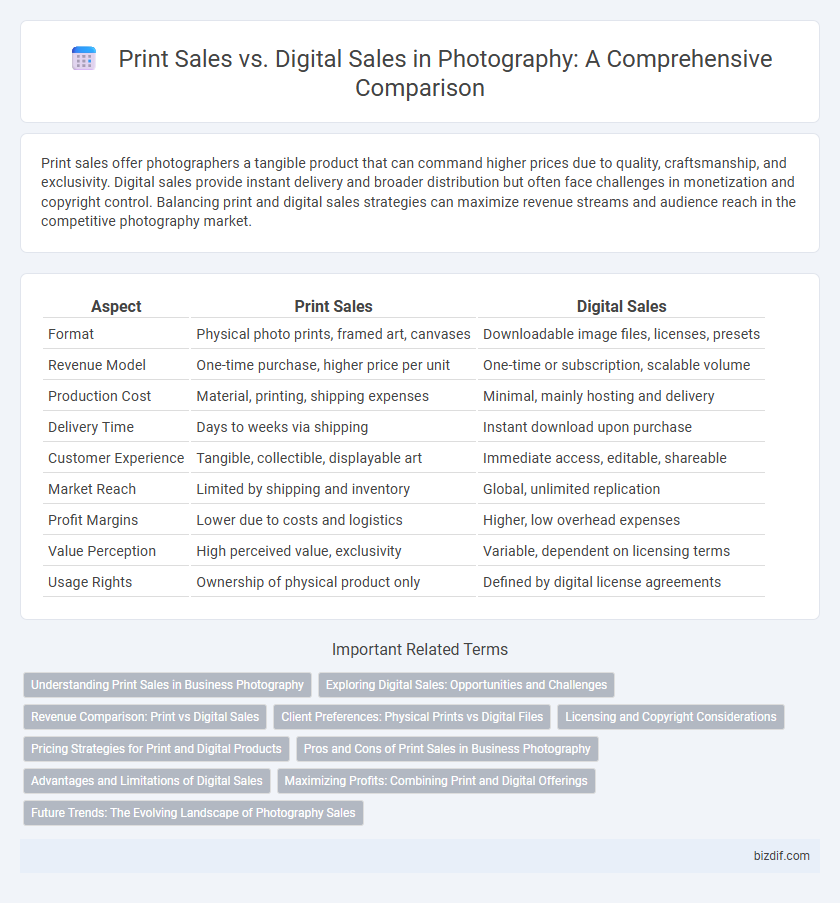Print sales offer photographers a tangible product that can command higher prices due to quality, craftsmanship, and exclusivity. Digital sales provide instant delivery and broader distribution but often face challenges in monetization and copyright control. Balancing print and digital sales strategies can maximize revenue streams and audience reach in the competitive photography market.
Table of Comparison
| Aspect | Print Sales | Digital Sales |
|---|---|---|
| Format | Physical photo prints, framed art, canvases | Downloadable image files, licenses, presets |
| Revenue Model | One-time purchase, higher price per unit | One-time or subscription, scalable volume |
| Production Cost | Material, printing, shipping expenses | Minimal, mainly hosting and delivery |
| Delivery Time | Days to weeks via shipping | Instant download upon purchase |
| Customer Experience | Tangible, collectible, displayable art | Immediate access, editable, shareable |
| Market Reach | Limited by shipping and inventory | Global, unlimited replication |
| Profit Margins | Lower due to costs and logistics | Higher, low overhead expenses |
| Value Perception | High perceived value, exclusivity | Variable, dependent on licensing terms |
| Usage Rights | Ownership of physical product only | Defined by digital license agreements |
Understanding Print Sales in Business Photography
Print sales remain a significant revenue stream in business photography, offering tangible value through high-quality physical products such as framed prints, canvas wraps, and promotional materials. Clients often prefer prints for branding purposes, office decor, and client gifts, which enhances perceived professionalism and long-term engagement. Mastering print sales involves understanding pricing strategies, print production costs, and effective presentation techniques to maximize profitability and client satisfaction.
Exploring Digital Sales: Opportunities and Challenges
Digital sales in photography offer unprecedented global reach and instant delivery, enabling photographers to tap into diverse markets without physical limitations. Challenges include intense competition, pricing pressures, and the need for strong online marketing strategies to stand out in crowded digital platforms. Leveraging SEO, social media, and secure payment systems can maximize revenue while protecting intellectual property in digital transactions.
Revenue Comparison: Print vs Digital Sales
Print sales generate higher revenue per unit compared to digital sales due to the tangible value and limited edition appeal of physical prints. Digital sales offer lower per-unit revenue but benefit from scalability and instant global distribution, often resulting in higher overall volume. Photographers aiming to maximize revenue should balance print's premium pricing with digital's broad market reach.
Client Preferences: Physical Prints vs Digital Files
Clients seeking tangible memories often prefer physical prints due to their aesthetic appeal and long-lasting quality, making print sales a lucrative avenue for photographers. Digital file sales cater to a tech-savvy clientele valuing convenience, easy sharing, and instant access, expanding market reach. Understanding that some customers prioritize wall art and albums while others desire versatile digital images helps photographers strategically balance offerings to maximize revenue and satisfaction.
Licensing and Copyright Considerations
Print sales generate revenue through tangible products, requiring photographers to manage physical copyrights and control reproduction rights, while digital sales emphasize licensing agreements that specify usage terms and distribution limits. Licensing in digital photography often involves complex copyright considerations to prevent unauthorized sharing and ensure proper royalties, contrasting with the more straightforward ownership transfer in print transactions. Understanding these distinctions helps photographers maximize income and maintain intellectual property protection across both mediums.
Pricing Strategies for Print and Digital Products
Print sales often demand higher pricing due to production costs like materials, printing, and framing, while digital sales benefit from minimal overhead, allowing for lower prices and volume-based discounts. Implementing tiered pricing strategies, such as premium pricing for limited edition prints and subscription models for digital collections, maximizes revenue across channels. Understanding customer preferences and perceived value is essential for optimizing price points and enhancing profitability in both print and digital photography markets.
Pros and Cons of Print Sales in Business Photography
Print sales in business photography provide tangible products that enhance client satisfaction and allow photographers to charge premium prices, boosting revenue. However, print production involves higher costs, including materials, shipping, and potential damage risks, which can reduce profit margins. Limited scalability and inventory management challenges pose additional drawbacks compared to the low-overhead, infinitely reproducible nature of digital sales.
Advantages and Limitations of Digital Sales
Digital sales in photography offer the advantage of instant global distribution and reduced production costs, making images accessible to a wider audience without physical inventory constraints. However, limitations include potential quality loss due to compression, challenges in copyright enforcement, and the intangible nature of digital files which may reduce perceived value compared to physical prints. These factors require photographers to balance accessibility with control and monetization strategies in the digital marketplace.
Maximizing Profits: Combining Print and Digital Offerings
Maximizing profits in photography requires a strategic balance between print sales and digital sales, leveraging the unique value of each. Offering high-quality prints caters to collectors and clients seeking tangible art, while digital sales provide instant access and scalability through licensing and downloads. Combining these revenue streams increases overall profitability by reaching diverse customer preferences and expanding market opportunities.
Future Trends: The Evolving Landscape of Photography Sales
Print sales continue to hold strong appeal among collectors and art enthusiasts, driven by the tactile quality and exclusivity of physical photographs, with limited editions boosting their investment value. Digital sales are rapidly expanding through online platforms, enabling photographers to reach global audiences instantly and offering new revenue streams via NFTs and licensing for multimedia use. Emerging technologies such as augmented reality and blockchain are set to revolutionize both print and digital photography markets by enhancing authenticity, provenance, and interactive viewer experiences.
Print Sales vs Digital Sales Infographic

 bizdif.com
bizdif.com